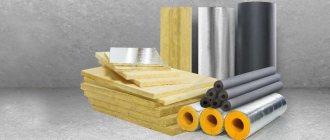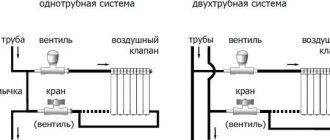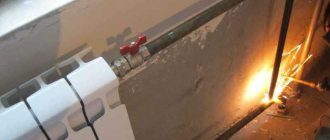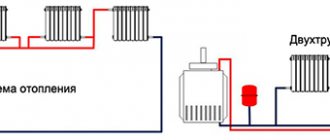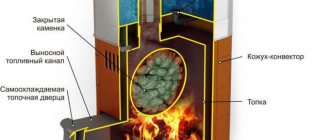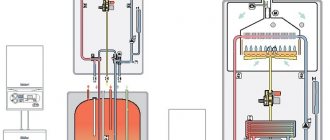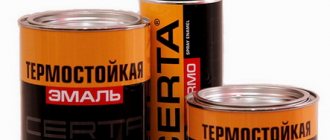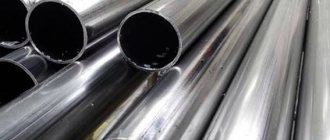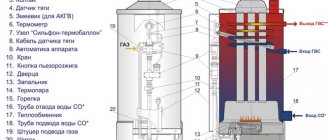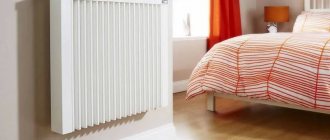Do I need to paint radiators?
Previously, painting radiators was used not only to improve the appearance of the heating system, but also to prevent corrosion. The performance of the batteries depended on the quality of the paint.
If the coating was damaged, the metal began to rust and a leak appeared.
Nowadays radiators are made of corrosion-resistant metals, so painting is done for decorative purposes.
Original ideas for painting radiators.
Interesting battery color ideas
Heating appliances are painted to match the walls. An alternative to this is to create an accent in the room by changing the color of the radiator. For example, if the walls are light, the radiators can be made bright, but only if such a tone is already present in the room.
In the nursery, patterns are drawn on the radiators and each section is painted in different shades.
The ombre technique is popular, when the outer sections on one side are covered with bright, saturated shades, and on the other end, light-colored paints are applied in the same range with a smooth transition from dark to light colors.
Read further:
Painting hot batteries: choosing the right paint, step-by-step painting technology
Paints for heating radiators: types and varieties of compositions, popular brands of paints
Painting heating pipes: how and what to paint with, step-by-step instructions.
Painting bathroom walls: choosing paint and surface preparation, step-by-step painting instructions and different methods
High-quality painting of heating radiators with powder paint with hot polymerization
Requirements for the coloring composition for radiators
Odorless enamel for heating radiators should:
- Do not collapse when heated to high temperatures. The properties of the coating should not change.
- Good adhesion to the base. The decorative layer should not peel off when heated.
- Contain anti-corrosion additives. This is necessary so that the coloring agent does not cause rust.
- Have a stable color. The main reason for painting is to give radiators an aesthetic appearance. White paint should not yellow over time.
- Be abrasion resistant. The layer should not become thinner during cleaning or contact with different objects.
- Does not contain toxic components. When heated, the decorative layer should not emit toxic fumes.
Alkyd enamels
Positive traits:
- resistance to high temperatures;
- wear resistance, due to which the neat appearance of the batteries is maintained for a long period.
Such properties make it possible to paint heating radiators. Alkyd enamel protects devices from rust, increasing their service life. When applied, it lays flat, so no adjustments are required to the coating. There are a large number of shades of alkyd enamel, so you can always choose the right tone to suit your interior.
Alkyd enamels for painting heating radiators.
Alkyd enamel is stronger than most analogues. Its disadvantage is the release of toxic fumes, the reason lies in the solvent content in the composition.
The smell is strong, dissipates slowly - 1 day after painting. During this time, you need to leave your home, and the room should be ventilated. Sometimes the smell is faint even after drying.
When looking for an answer to the question of how to paint a heating radiator at home, pay attention to the ability of paintwork materials to maintain the original tone.
Alkyd enamel quickly loses its shade and turns yellow, although it continues to retain its strength and other properties. The yellowness is more pronounced if the color chosen is white. When purchasing alkyd enamel, it is better to consider darker tones with a glossy sheen.
Please note: Painting doors: choosing a paint material, step-by-step instructions for painting, how to choose a color
Types of paints for heating radiators
Manufacturers produce different types of paint and varnish products.
Studying the properties of each type will help you understand whether batteries can be painted with water-based paint, and which composition will best protect the metal.
The following products are suitable for processing batteries:
- alkyd;
- acrylic;
- oil;
- water-dispersed;
- silicone.
These types differ in performance characteristics and application methods.
Oil based
Outdated products for indoor work are now rarely used. The advantages of the compositions under consideration include:
- availability of transparent and colored options;
- ease of application to metal elements;
- formation of a uniform durable layer;
- low cost compared to other types of coloring agents;
- Possibility of use for applying ornaments and complex designs.
Disadvantages include a strong odor and a long drying time for each layer. These characteristics are due to the addition of oil solvents. This enamel should not be applied to hot radiators.
Heat-resistant alkyd enamels
Such paints, produced using modern technologies, have the following positive qualities:
- resistance of the decorative layer to temperature changes (the coating does not crack when heated to +120 °C);
- increased strength;
- homogeneity of the structure of the product during application;
- insensitivity to abrasion during normal operation of heating radiators;
- a wide selection of shades, helping you find an option that suits the overall design;
- maintaining the integrity of the layer for 5-10 years.
Alkyd enamels also have disadvantages. The pungent odor persists for a week after application. The coating begins to smell when the batteries are very hot. Some products fade and change color. Each layer dries for at least 12 hours.
One of the main disadvantages of alkyd paint is its pungent odor.
which also manifests itself when the batteries are very hot.
Metallic silicone paints
In the production of such products, silicone resins and aqueous or organic solvents are used. The positive qualities of silicone products include:
- Heat resistance. The coating can withstand any temperature loads encountered in heating systems.
- Easy to apply. When using silicone enamel, it is not necessary to carefully prepare the metal base.
- Abrasion resistance. The decorative layer is not damaged by mechanical stress.
When choosing what paint to paint heating pipes in an apartment, the homeowner must remember the high cost of silicone compounds. This is considered the main disadvantage of such funds.
Acrylic enamels
These colors:
- They do not have a pungent odor. They are well suited for work in residential areas.
- Dries quickly. This explains the frequent use of acrylic enamels in everyday life.
- Resistant to moisture.
- Apply evenly to the surface and cover the metal base well.
- Safe for humans. The composition does not contain toxic solvents.
- Retains properties when heated. The coating does not turn yellow when the temperature rises and does not crack.
- Combines with any colors. Due to the possibility of obtaining a wide range of colors, paint is used for artistic decoration.
The disadvantage is considered to be high cost. However, it is compensated by the good performance characteristics of the product.
Powder formulations
The technology involves applying a powder that melts and adheres to the base when heated. Powder paints are divided into the following types:
- epoxy;
- polyester;
- polyacrylate;
- photochemical;
- thermoplastic.
When used as directed, enamel is safe.
However, automotive compounds cannot be used to paint radiators.
Such products are not intended for use in residential buildings. When heated, they can release substances hazardous to human health.
Matte and glossy compositions
When choosing paint, you need to take into account the texture of the finished coating. It can be glossy or matte. The first type highlights all surface defects. When painting cast iron batteries, it is better to choose matte options. The alloy has a rough structure that will stand out sharply after being coated with shiny paint. A glossy compound is suitable for processing bimetallic radiators.
Water based
This paint is considered the best option for working indoors. It differs from other means in the following features:
- lack of odor;
- safety for humans and nature (enamel is produced on the basis of plain water, dispersed fillers are also not considered harmful);
- quick drying (each layer sets in 2-3 hours);
- ease of application, uniform distribution;
- water-repellent properties (with infrequent washing of batteries, the layer remains for 3-4 years);
- Can be used in any room, including children's rooms and bedrooms.
Water-dispersion paint is available in the form of a white base, which can be tinted in pastel shades.
Features of paint application
Before painting, the heating radiator must be cooled. This is because most paints are designed to be applied to a cold surface. If they are applied to hot metal, they will dry quickly. And this will not allow you to apply an even layer and correct smudges, stains and stains in a timely manner. In any case, provided that you work on hot batteries. There is very little time to apply paint. In this case, the mistake made may remain uncorrected. This is often noted in various videos.
True, there are some exceptions
So, people who ask the question whether it is possible to paint hot batteries should pay attention to paints specially designed for this purpose. They are able to dry on heated metal very slowly
However, such paints are quite expensive, and the final result of calculating a small repair will be a considerable amount. Therefore, before painting the heating radiator in winter, it is better to turn it off and wait for it to cool. It is best to change the color of the heating device in the summer season. Then it is convenient to ventilate the room and the radiators are cold.
If you have to paint a cast iron heater with ordinary paints during the heating season, then you need to apply a very thin layer of paint. Apply two such layers.
The application of a color mixture of a certain color occurs in the following sequence:
- Place oilcloth or old pieces of newspaper under the radiator.
- Applying paint to the top of the product. Then they gradually go down. Thanks to this, the problem of smudges is eliminated. First, the color mixture is applied to the internal parts of the device, and then to the external parts. The entire surface needs to be painted.
- Drying of the first layer of paint.
- Apply the second layer in the same way as the first.
The battery is coated with paint using various tools, namely:
If you plan to use a brush, then you should take several options. The first should have soft, straight bristles. The other has curved stubble. Thanks to the second, you can work with your own hands in those places to which access is limited.
If painting with a spray gun, it is better to remove the battery. This way, excess paint will not get on the walls. In addition, there is a great opportunity to paint the most inaccessible places.
https://youtube.com/watch?v=O2LHdXtcOh4
Spray painting is very quick. In this case, you need to perform zigzag movements. They move from top to bottom. The distance from the surface to be treated to the can should be 30 cm.
Features of choosing paint for heating batteries
When purchasing paints for radiators, you need to consider the following characteristics:
- hiding power (the consumption of the product depends on this parameter);
- heat resistance (preservation of properties when heated);
- color stability;
- drying time.
The paint is selected in accordance with the material from which the heating system elements are made:
- It is recommended to paint aluminum, steel and bimetallic products with acrylic or alkyd enamels. Water-based products are also suitable.
- Cast iron batteries can be painted with any composition. However, the product must be distributed in a thin, uniform layer, so thick paint is mixed with a thinner.
You should avoid using oil paint, even if it is produced by a trusted manufacturer. This product does not perform the required decorative and protective functions; it smells unpleasant when heated.
Instructions for painting batteries
At the first stage, you need to purchase tools, remove old paint, clean and prime the surfaces. After this, you can begin staining.
Tools and consumables
To process radiators you will need:
- brushes;
- brush attachments;
- sandpaper;
- degreaser;
- primer for metal with anti-corrosion additives;
- solvent of the desired type;
- abrasive for removing a thick decorative layer.
Cleaning the radiator from external contaminants
The batteries are washed with soapy water, removing traces of dust and dirt. Before removing paint from surfaces, dry them.
Removing old coating
To remove the cracked layer, you can use sandpaper or a brush attachment. If particles of old paint remain after processing, the recesses between them are sealed with metal putty.
Sanding the surface
This action is required to obtain an even coating. Sanding of radiators begins after the putty has completely dried. All radiator elements are cleaned with sandpaper.
Primer coating
At this stage, perform the following actions:
- Degrease the metal with white spirit or a weak alkali solution. Wait for the product to dry.
- Apply the first layer of metal primer. After drying, you can begin re-processing.
Applying dye
When painting, observe the following rules:
- Before starting work, turn off the device. The radiator temperature should be equal to room temperature. However, the metal cannot be cooled below +15 °C. This prevents polymerization and drying of the coloring agent.
- It is advisable to disconnect and remove the battery. This will help coat back surfaces and hard-to-reach areas evenly.
- Do not forget about processing the internal and lower parts of the radiator.
Coloring is done as follows:
- Use a thin brush to cover the inner ribs. You need to rub the dye thoroughly. There should be no leaks.
- Wait until the product dries and apply a second layer on top. At the same time, the front sides of the sections are processed. It is advisable to apply several layers of paint so that there are no gaps.
- Dry the coating for 12 hours. At this time, you cannot connect the battery to the heating system. Correctly applied paint will last at least 5 years.
How to paint a heating radiator at home with your own hands.
Before starting painting work, you should correctly determine the sequence of stages of its implementation:
- First of all, you should decide on the time of staining. It is best to carry out work at a surface temperature of 15 to 25 degrees. Paint applied at this temperature will not begin to leak or peel. Therefore, work must be planned for the time when the central heating is turned off.
- If you are painting batteries of complex shape (eg old cast iron), it would be better to remove them. Otherwise, there will be uncleaned areas and areas without paint on the radiator.
- When cleaning old radiators, it is best to treat them using a grinder. cars. You can also use a drill equipped with a wire brush. Old paint, sanded before processing. machine, can be heated using a hair dryer. Heated paint will be easier to clean off.
Removing old paint from a heating radiator - In addition to mechanical cleaning, you can use various chemical solvents (rinses). With their help, the paint will soften and peel off more easily. It is worth purchasing removers with a corrosion inhibitor. This will subsequently delay the development of corrosion on the radiator.
Chemical cleaning of batteries from paint - After rough machining using a grinding machine. machines or drills, the surface to be painted must be cleaned with sandpaper. When cleaning radiators made of thin-walled metal, it is necessary to use fine-grained sandpaper.
Removing old paint from batteries - Then you need to clean the surface to be painted with a brush to get rid of dust. It is also better to carry out wet cleaning.
- If, after cleaning, too large irregularities are discovered on the surface, you can cover this part with metal putty to level the surface. After the putty has dried, it is necessary to clean it again.
- The surface to be painted should be degreased with acetone or gasoline. The choice of acetone or gasoline depends on the paint used. But, in the case of using alkyd paint, degreasing is carried out with gasoline. And if you use acrylic paint, you need to use acetone.
- New or completely cleaned radiators need to be primed. The type of primer will depend on the base of the paint on which it is made and must match it. After applying the primer, it must dry completely.
- The final stage will be coloring. It can be done using brushes, rollers, spray guns or aerosol cans. If using a spray gun, the paint must be diluted with 10% water. You can also use a solvent.
Painting radiators
Painting almost always takes place in 2 layers. Applying the second layer is possible only when the first layer has dried. When painting a radiator of complex design, it is worth using narrow brushes of various shapes.
Reasons for unsuccessful painting
After staining, the following defects may appear:
- Peeling of coating. Occurs due to lack of surface priming. Special compounds improve the adhesion of paint to the base. In addition, they help get rid of small dust particles. Remaining fatty traces can also contribute to detachment. To eliminate the defect, clean the radiator, degrease and prime it.
- Peeling and cracking. The main reason is a violation of surface preparation and painting technology. High air humidity, application of enamel in a thick layer, and improper preparation of the metal also contribute to cracking. In this case, the paint is removed, the base is cleaned again, and it is primed.
- The appearance of wrinkles. Defects are discovered after applying a new layer on top of an undried previous one, using too viscous compositions, lowering the air temperature, or using an inappropriate thinner. The wrinkled coating must be removed and the radiator treated with enamel of the correct consistency.
- The appearance of pores or bubbles. They arise due to the use of expired or low-quality paint, applying the product in a thick layer, or using wet brushes. The damaged coating is removed with an iron brush, coated with a primer, and dried. Apply a new layer of enamel using a dry instrument.
- The appearance of streaks and streaks. The main reason is the use of a wet brush or thick paint. Also, streaks appear when applied in different directions, temperature changes, or poor mixing of the composition after adding color. In this case, the coating is removed, a primer is applied, and wait until it dries. The paint is applied in one direction with a dry brush. If there are small stripes, separate areas are cleaned. After this, they are painted with enamel of a suitable tone.
- The appearance of rusty or dark spots. Such a defect is detected in the presence of fatty or resinous traces on the surface to be painted or improper distribution of the primer. The enamel in some places is absorbed less well, which is why dark spots appear. Damaged areas must be cleaned and treated with a degreaser. A new layer of enamel is applied.
- Revealing of old coating. New paint can corrode the old layer and react with it. Because of this, the previous color appears from under the new one or mixes with it. To eliminate the defect, completely clean the metal from the coating and reapply the enamel.
- Drips. They occur when using liquid enamel or applying a large amount of product. The drips are removed with sandpaper, and a thicker paint composition is used.
Features of paint application
Applying one or another type of paint to radiators is not quite a simple job, as a person who is far from understanding the technology of painting work might think. After all, the reliability of the coating and its durability will depend on how correctly all the stages of painting were followed.
Preparatory stage
Painting with acrylic paint
Preparing radiators for painting is the most important and first stage, on which the final result largely depends. First, you need to thoroughly wash the heating device, using for this purpose a special spray bottle with washing liquid, a soft cloth and a brush. Even new batteries require preliminary preparation, since even the highest quality paints without their characteristic odor should lie smoothly and evenly on the surface. Next, you need to degrease the devices and also clean them with sandpaper to remove various irregularities on their surfaces and better adhesion to the paint.
Before applying the coloring composition, you should remove the old coating layer, and also treat areas susceptible to corrosion with special compounds.
Preparation of tools and materials
Before removing the old layer of paint and applying a new coating, you need to make sure you have the necessary tools and abrasives on hand:
- Tassels.
- Drill brush attachments.
- Sandpaper used to remove old paint.
- Degreasing composition.
- Primers with components to protect metal from corrosion.
- Abrasive - for removing thick layers of old coating.
Features of applying paint to radiators
Acrylic enamel for radiators
In order for the final result to be what you expect, you should not only choose the right paint, carry out all the preparatory work carefully, but also apply a new composition according to the rules:
All restoration and painting work should be carried out during a heating shutdown to avoid streaks and unsightly stains. It is important to apply paint from top to bottom so that any random drips that may appear do not spoil the already treated surface. Batteries must be completely covered, including the back and inside of them.
In order to paint hard-to-reach places, there are special battery brushes that have a curved shape. It is most effective to treat the device in two thin layers to avoid unevenness. But in this case it is necessary to wait until the first applied layer is completely dry. And only after this can the next layer of paint be applied. The aesthetics of the battery will depend on how carefully the paint, oil or any other, is used. For convenience, spray cans, special rollers and brushes are often used. It is recommended to start the process from the most inaccessible places, applying the composition evenly. If the technical parameters of the radiator allow it to be removed from its hinges and completely covered with paint, then this will be the best option.
When carrying out painting work in the summer, it is necessary to keep the windows open to protect yourself from the negative effects of coloring compounds. In addition, you need to use respirators and gloves so that after finishing work on painting batteries, you do not damage the skin of your hands with various solvents when scrubbing off paint stains.
The best paints for radiators
Studying the rating will help you understand which product is best to use for painting heating system elements.
Oil formulations
Such products are gradually losing popularity, which is explained by the pungent odor and rapid loss of properties of the finished coating. However, some owners of houses and apartments continue to buy them due to their low cost. The following tools were included in the rating of the best:
- DekArt MA 15. The product is well suited for processing metal elements. The manufacturer offers a variety of colors, so it’s easy to find a product that matches your interior. DekArt MA 15 products are manufactured according to standards. It protects radiators well from negative factors, creates a beautiful durable coating, and has bright, rich colors. The disadvantage is the release of a pungent odor when working with the composition.
- Sniezka Supermal. The product can be used to paint cast iron and steel radiators. It can be used in public institutions: production shops, clinics, schools. The advantages include insensitivity to atmospheric factors and mechanical influences, minimal consumption, brightness of tones. There were no shortcomings other than an unpleasant odor.
The best oil paints for radiators.
Water-based paints
The list of the best includes the following brands:
- Radiator Festek. The one-component water-based composition is resistant to moisture and has a matte white color. The advantages include lack of odor, abrasion resistance, and long-term tone retention. The finished coating can withstand temperatures up to +90 ºС. Fast drying reduces repair time. The disadvantage is sensitivity to increased operating loads.
- Remontti Assa Tikkurila. The semi-matte product contains acrylate binders. Organic solvents in it are replaced by an aqueous base. The products are completely safe even for people suffering from allergies or asthma. The finished coating is resistant to wet cleaning and abrasion. The high cost makes the paint not accessible to everyone.
- Farbex Polisan. The products are produced taking into account all current standards. The paint dries in 1-2 hours. The finished coating has a pleasant white color and glossy shine. Farbex Polisan adheres well to metal substrates and can be washed with mild cleaning agents. It is possible to tint the white base in pastel colors. The disadvantage is the need to carefully prepare radiators for painting. Traces of alkyd or oil paint are removed to the base.
- Balakryl Radet. Czech paint is well suited for treating heating systems in residential and public buildings. The advantages include resistance to water, the ability to be used in rooms with high air humidity, and preservation of properties when heated to +100 °C. The paint can be used for walls and ceilings. No deficiencies were identified.
The best brands of water-based radiator paints.
Alkyd enamels
The best in this category are:
- Krafor is a heat-resistant alkyd enamel. The finished coating has water-repellent properties. One layer dries completely within 14 hours. The composition thickens during storage, but is easily diluted with white spirit. The advantages include affordable price, pleasant white color, shine. The paint has a strong odor and takes a long time to dry, so it is rarely used when working in living rooms.
- "Prestige Premium". Hammer enamel with metal impurities was created specifically for the treatment of heating systems. The composition is resistant to heat and has anti-corrosion properties. The product does not contain toxic solvents, so it does not have an unpleasant odor. One layer dries in 10 hours. It is allowed to dilute the paint with water. No defects were found in this enamel.
- DALI, which forms a durable coating that is resistant to extreme heat. The facing layer has a glossy shine, it repels dust and dirt. DALI can be used for painting cast iron or steel batteries. The product is well distributed with a brush or spray gun. It is diluted with solvent or white spirit. It takes 6 hours for one layer to dry. Complete hardening occurs within a day. After 10 days, the layer acquires the required strength.
- "TEX Pro". Designed for processing metal elements that heat up during operation. Once dry, it forms a semi-matte white finish that resembles plastic. It can be washed with any means. The base can be easily tinted in any color. The advantages include affordable price, convenient packaging, quick drying, color retention. The disadvantage is the unpleasant odor that persists until it dries completely.
- "Olecolor heat resistant." The product is designed to protect wood and metal. The composition is completely ready for use. The layer that has gained strength can withstand the heat typical of heating systems. Warm batteries may be painted. The coating has a semi-gloss sheen. The advantages include ease of removal with a solvent, high drying speed, and a pleasant white color. The disadvantages are the smell and too liquid consistency.
The first five alkyd paints for radiators.
Acrylic compounds
The best in this category are:
- "Prestige Ferrum Premium". Heat-resistant enamel on metal creates a semi-matte layer. There is no unpleasant odor when applied. One layer sets in an hour, after which the product can be reapplied. It takes at least a day to fully gain strength. You can dilute the thickened composition with plain water. The enamel is produced in the form of a white base, subject to tinting.
- "Lakra." The paint, diluted with water, has no chemical odor and is resistant to heating up to +100 °C. The decorative layer does not fade or turn yellow over time. Each layer dries in 8 hours. The coating has water-repellent properties. The composition is available in ready-to-use form. The advantages include fast drying, good hiding power, white color without yellowing.
- Decor. The product does not contain organic solvents or other toxic substances. Therefore, it can be used for painting batteries in bedrooms and children's rooms. Universal enamel is used for processing wooden and metal substrates. The product forms a vapor-permeable, waterproof coating. Dilution with water is allowed, the volume of which should not exceed 10% of the amount of material. The enamel is applied with a brush or spray. A thin layer dries in an hour.
- "TEX Universal". Heat-resistant enamel can withstand heating up to +75 °C, short-term temperature increases up to +120 °C. The paint can be used not only for painting radiators, but also for treating walls, ceilings, and window frames. It covers well the previously applied acrylic or alkyd enamel and creates a semi-gloss finish. The white base can be tinted in any color. The medium viscosity of the composition prevents the formation of streaks and facilitates application. Long drying time is considered the main disadvantage.
- "AURA LUXPRO TERMO". The product is intended to create a semi-gloss decorative layer that can withstand the heat inherent in heating systems. Anti-corrosion additives prevent the appearance of rust. The paint covers layers of oil or alkyd enamel well. White color lasts for 5 years. Coloring with pastes or powders is allowed. The disadvantages include the high price.
Leading brands among acrylic paints for radiators.
How to choose the right coating for radiators
Any specialist involved in the repair of pipes and radiators, when asked what paint is best to paint heating radiators, will answer:
- The paint coating must be thin and with maximum thermal conductivity of the paint layer in order to ensure good heat transfer to the room air;
- The paint must provide protection to the metal surface;
- The coating must withstand heating temperatures of up to 150°C for high-pressure radiators and 120-130°C for conventional steel or cast iron batteries.
For your information! Paint for cast iron radiators, in addition to all the above conditions, must have high fluidity and low viscosity.
Even after priming, the cast iron surface remains quite rough and porous, so aerosol molds are the best choice for cast iron. The radiator is painted in several passes, each layer must be thoroughly dried and any stains removed. As a rule, heat-resistant spray paint for radiators has a very low odor, but it is necessary to paint installed radiators only with the windows open, in dry, warm weather.
For conventional steel and aluminum heating radiators, the use of aerosols allows you to apply a thin layer to the most hidden places where it is difficult to reach with a brush or roller. In addition, a thin layer of enamel dries 2-3 times faster, which means that even if there is a slight odor, it will disappear in half an hour. The smell from a thick layer of enamel on an organic solvent will stay on the radiator for 5-6 hours, for oil or pentaphthalic paint - for several days.
Heat resistance and volatility of paint for heating appliances
First of all, it should be noted that odorless paint for heating radiators does not exist in nature. Any enamel has a slight but pronounced odor. Even paints for heating appliances, interior wall decoration based on acrylic polymers, or simply water-based brands also have an odor.
Ask a store clerk or building materials showroom for odorless radiator paint, and he will give you a whole list of heat-resistant enamels with the word “odorless” on the label. Actually this is not true. If you take the most seemingly safe water-based paint and paint a heating radiator at a temperature of 30-45°C, the smell will be quite unpleasant.
Imported, for example, Polish, Czech or German paints for interior work and heating radiators may have virtually no odor or have a light pleasant aroma, for example, of fresh ice cream or sawn wood. But this does not mean that such odorless radiator paint is absolutely safe and cannot affect your well-being.
Production technology makes it possible to skillfully mask the real smell of paint, therefore, imported paints and varnishes use a special index of volatile organic compounds, or in the abbreviated version - VOC. Instead of a vague concept of odor, VOC precisely defines the maximum content of volatile organic compounds that will have to be inhaled when painting a heating radiator. Even for safe, and practically odorless, acrylic enamel for heating elements, the standard allows no more than 130 g of organic volatile substances per liter of material.
The easiest way is to determine the heat resistance of the paint and varnish material. The label of a can of enamel for heating systems always indicates the maximum temperature of the radiator at which the coating can be applied and the upper limit for heating the battery. For central heating systems, the coolant temperature rarely exceeds 100°C, but in private homes, part of the pipes that drain hot water from the boiler heat exchanger can heat up to 120-130°C.
